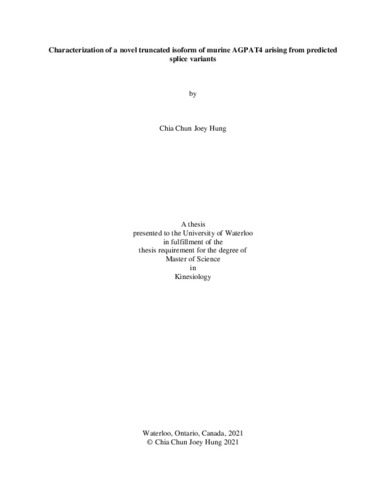| dc.description.abstract | The acylglycerophosphate acyltransferase (AGPAT)/lysophosphatidic acid acyltransferase (LPAAT) family of enzymes is responsible for the conversion of lysophosphatidic acid (LPA) to phosphatidic acid (PA), a precursor of de novo triacylglycerol and glycerophospholipid synthesis. Specifically, a fatty acyl group is attached to the sn-2 position of LPA to form PA. There are eleven AGPAT/LPAAT enzymes identified in humans and mice. Murine AGPAT4/LPAATδ is an outer mitochondrial membrane (OMM) protein, which is highly expressed in whole brain and brain subregions and is linked to phospholipid regulation, learning and memory function, as well as muscle force contractility and adipose tissue structure. The murine AGPAT4 reference protein variant NP_080920.2 has been experimentally characterized, while a truncated form of the AGPAT4 enzyme (generated by the coding regions of at least two different predicted splice variant transcripts, XM_006523348.4 and XM_006523347.3) was predicted to exist through the gene prediction tool Gnomon but had not yet been studied. This thesis reports the first identification and quantification of the predicted splice variants of murine Agpat4 in various tissues, and reports a heterogenous expression of the variants among the tissues studied, although in all tissues, the reference transcript was much more abundant. A novel cloning vector expressing the truncated AGPAT4 protein variant with a hemagglutinin tag was generated using molecular cloning for use in protein-protein interaction studies. Protein pull-down assays were performed to investigate if the truncated AGPAT4 protein variant directly interacts with the reference AGPAT4 protein, but did not yield evidence of an interaction. Finally, a series of scaled co-transfection experiments for reference AGPAT4 and truncated AGPAT4 were performed to determine whether the truncated AGPAT4 variant plays a role in modulating the levels of the reference AGPAT4 variant. Analyses of immunoblots revealed that the reference AGPAT4 protein modulated levels of the truncated AGPAT4 variant, but expression of the truncated protein variant did not significantly modulate the reference AGPAT4 protein in vitro. In short, this thesis has determined Agpat4 splice variants X1, X2, and X3 are endogenously synthesized in various murine tissues, and that truncated AGPAT4 protein levels may be modulated by the co-expression of reference AGPAT4 protein, in vitro. | en |

